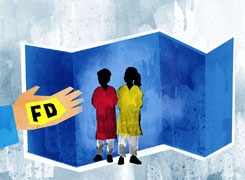How To Build a 1cr Portfolio At 25 Years Old With 35k Salary: Reader's Dilemma
Ramalingam Kalirajan |8317 Answers |Ask -Follow
Mutual Funds, Financial Planning Expert - Answered on Aug 23, 2024
He has an MBA in finance from the University of Madras and is a certified financial planner.
He is the director and chief financial planner at Holistic Investment, a Chennai-based firm that offers financial planning and wealth management advice.... more

Sir I want 1cr in my bank Account And now im 25 years old Im Doing a job and my Salary 35000 I have some Investment Iike I have 3 mutual funds 1Small cap, 1Large&Midcap and 1Nasdeque 100, Im Investing 10000/Month In Mutual funds, I also have Some Some Stocks And My All Stocks are Small and Midcap and Portfolio value 6L Now I also Investing on Cryptocurrency and my Cryptocurrency Portfolio value Now 2L 1Thousand .Plz Guide me to make 1cr
Salary: Rs 35,000 per month.
Monthly Mutual Fund Investments: Rs 10,000.
Mutual Fund Portfolio: Small Cap, Large & Mid Cap, and International Equity (Nasdaq 100).
Stock Portfolio: Rs 6 lakhs, primarily in Small and Mid Cap stocks.
Cryptocurrency Portfolio: Rs 2.01 lakhs.
You’ve taken steps in the right direction by diversifying your investments. However, achieving Rs 1 crore will require a more focused and disciplined strategy.
Analyzing Your Investment Portfolio
Mutual Funds
Your current monthly investment of Rs 10,000 in mutual funds is a strong start. Diversifying across different categories is a smart approach that balances growth and risk.
Small Cap Funds: These funds offer high growth potential but come with high volatility. If your risk tolerance allows, continuing with small-cap investments can be beneficial for long-term wealth creation.
Large & Mid Cap Funds: These funds strike a balance between stability and growth. They should remain a core part of your portfolio as they perform well across different market cycles.
International Equity Fund (Nasdaq 100): Investing in international markets provides diversification benefits. However, they can be volatile due to currency fluctuations and global economic conditions. It's important to limit exposure based on your overall risk appetite.
Direct Stock Investments: A Rethink
While holding direct stocks can be exciting, it may not be the most prudent choice for long-term wealth creation, especially for someone at your stage in the investment journey.
High Risk and Volatility: Direct stocks, especially in the small and mid-cap categories, are highly volatile. Predicting the performance of individual stocks can be difficult and requires extensive research.
Better Focus on Mutual Funds: Instead of managing direct stocks, it’s wiser to channel your investments into mutual funds. They offer professional management, diversification, and the potential for steady returns without the need for constant monitoring.
Time and Expertise: Managing a stock portfolio requires significant time and expertise. Mutual funds, managed by experienced fund managers, allow you to benefit from professional research and decision-making.
Cryptocurrency Portfolio
Your cryptocurrency portfolio is valued at Rs 2.01 lakhs. Cryptocurrencies can offer high returns, but they are extremely volatile and speculative. It's advisable to limit your exposure to cryptocurrencies to a small percentage of your overall portfolio to manage risk.
Setting a Goal: Rs 1 Crore
To accumulate Rs 1 crore, a structured approach is essential. Here’s a step-by-step guide:
1. Increase SIP Contributions
Currently, you are investing Rs 10,000 per month. To reach Rs 1 crore faster, consider increasing your SIP contributions gradually. Even a small increase of Rs 1,000 per year can significantly impact your portfolio over time.
2. Focus on Long-Term Growth
With time on your side, focus on long-term investments. Avoid frequent withdrawals or switches. Let your investments compound over time, which is key to reaching your goal.
3. Regular Portfolio Review
While your current fund selection is solid, it’s important to review your portfolio regularly. Ensure that the funds you have chosen continue to perform well. Consider consulting a Certified Financial Planner to review your portfolio annually.
4. Rebalance Your Portfolio
As your investments grow, your portfolio may become unbalanced. For instance, if your small-cap funds outperform, they might take up a larger portion of your portfolio. Rebalancing your portfolio periodically ensures that it aligns with your risk tolerance and financial goals.
Evaluating Risks and Diversification
Avoid Over-Exposure to Risky Assets
Small Cap Funds: While these can offer high returns, they are also highly volatile. Ensure they do not dominate your portfolio. Diversify into large-cap funds for added stability.
Cryptocurrency: Given the speculative nature of cryptocurrencies, limit your exposure to avoid significant losses. A small allocation is fine, but your primary focus should remain on more stable investments.
Focus on Active Fund Management
Actively managed funds can outperform passive index funds, especially in a volatile market. Certified Financial Planners recommend actively managed funds for their ability to adapt to market changes and capitalize on opportunities. They may have higher expense ratios, but the potential for higher returns can justify the costs.
Regular Fund vs. Direct Fund Investments
Investing through a Certified Financial Planner in regular funds can provide you with expert guidance. Direct funds may seem cheaper due to lower expense ratios, but the lack of professional advice can lead to suboptimal investment decisions. A Certified Financial Planner helps in selecting the right funds, monitoring their performance, and rebalancing your portfolio as needed.
Additional Considerations
Emergency Fund
Before increasing your investments, ensure that you have an adequate emergency fund. An emergency fund should cover at least 6 months of your living expenses. This fund should be kept in a liquid and safe instrument, like a savings account or a liquid mutual fund.
Insurance Coverage
At your age, it’s crucial to have adequate insurance coverage. Ensure you have a term insurance policy to protect your financial dependents in case of an unfortunate event. Health insurance is also essential to cover any medical emergencies without impacting your savings.
Avoid Debt
Avoid taking on unnecessary debt. If you have any existing debt, prioritize paying it off. High-interest debt, like credit card debt, can significantly hinder your ability to save and invest. Keeping your finances debt-free will help you accumulate wealth faster.
Final Insights
Achieving Rs 1 crore requires discipline, patience, and smart financial planning. You’ve made a strong start by investing early and diversifying your portfolio. Now, focus on increasing your SIP contributions, balancing your risk exposure, and regularly reviewing your portfolio. Consulting a Certified Financial Planner can further enhance your strategy and help you stay on track. Remember, consistency is key. With disciplined investing, you can achieve your financial goals.
Best Regards,
K. Ramalingam, MBA, CFP,
Chief Financial Planner,
www.holisticinvestment.in
You may like to see similar questions and answers below
Milind Vadjikar |1206 Answers |Ask -Follow
Insurance, Stocks, MF, PF Expert - Answered on Sep 04, 2024
Ramalingam Kalirajan |8317 Answers |Ask -Follow
Mutual Funds, Financial Planning Expert - Answered on Sep 04, 2024
Milind Vadjikar |1206 Answers |Ask -Follow
Insurance, Stocks, MF, PF Expert - Answered on Oct 21, 2024
Ramalingam Kalirajan |8317 Answers |Ask -Follow
Mutual Funds, Financial Planning Expert - Answered on Feb 01, 2025
Milind Vadjikar |1206 Answers |Ask -Follow
Insurance, Stocks, MF, PF Expert - Answered on May 04, 2025
Radheshyam Zanwar |1593 Answers |Ask -Follow
MHT-CET, IIT-JEE, NEET-UG Expert - Answered on May 04, 2025
Vipul Bhavsar |68 Answers |Ask -Follow
Tax Expert - Answered on May 04, 2025
Vipul Bhavsar |68 Answers |Ask -Follow
Tax Expert - Answered on May 04, 2025
Vipul Bhavsar |68 Answers |Ask -Follow
Tax Expert - Answered on May 04, 2025
Radheshyam Zanwar |1593 Answers |Ask -Follow
MHT-CET, IIT-JEE, NEET-UG Expert - Answered on May 04, 2025
Dr Nagarajan Jsk |364 Answers |Ask -Follow
NEET, Medical, Pharmacy Careers - Answered on May 04, 2025

Best wishes.
POOCHO. LIFE CHANGE KARO.
Dr Nagarajan Jsk |364 Answers |Ask -Follow
NEET, Medical, Pharmacy Careers - Answered on May 04, 2025
Nayagam P P |4477 Answers |Ask -Follow
Career Counsellor - Answered on May 04, 2025
Nayagam P P |4477 Answers |Ask -Follow
Career Counsellor - Answered on May 04, 2025
























